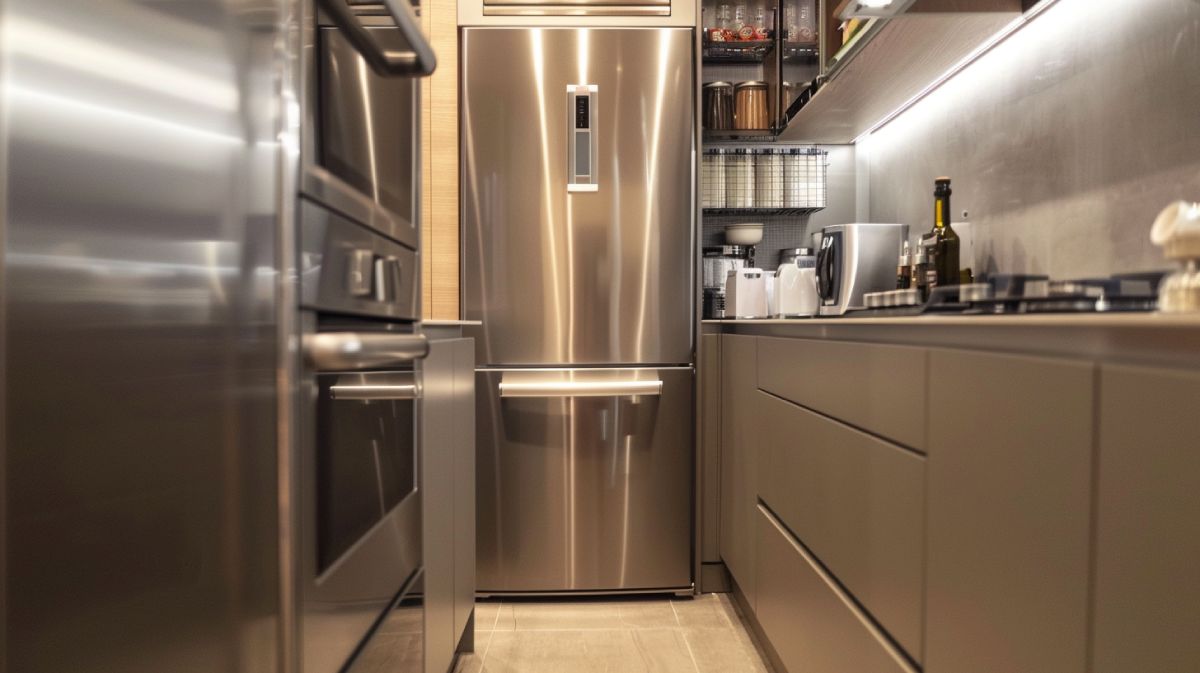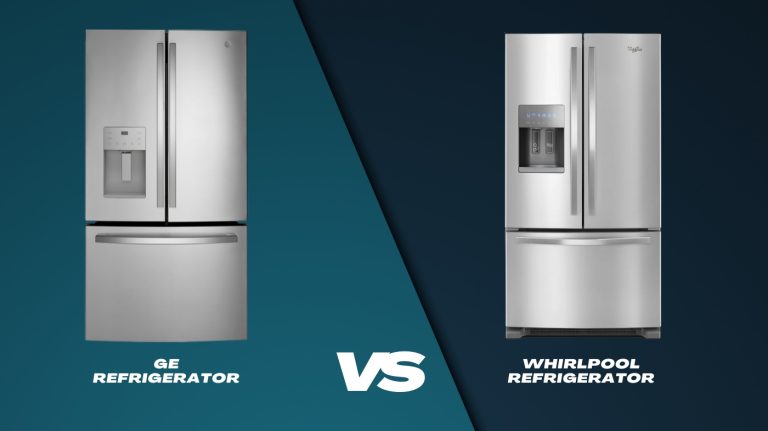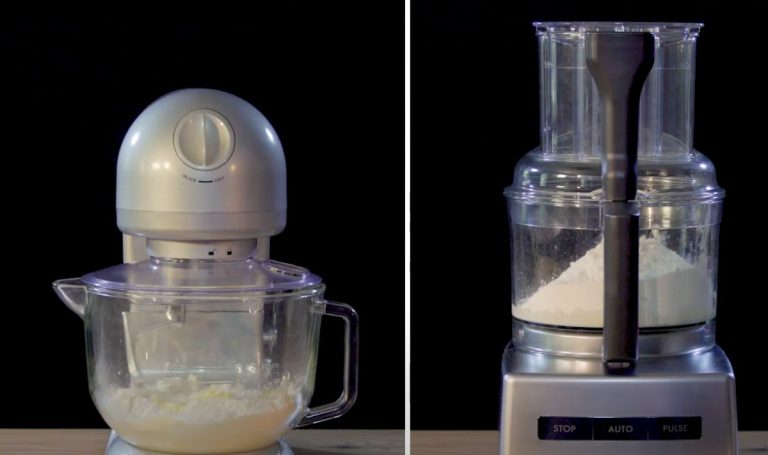How to Move a Refrigerator Out of a Tight Space: From Cramped to Clear
To move a refrigerator out of a tight space, start by evaluating the area and measuring doorways and hallways for clearance. Gather tools like an appliance dolly, furniture sliders, and moving blankets. Empty the fridge and unplug it, securing the power cord. Clear the path of obstacles and consider removing doors for extra room.
Use proper techniques: rock the fridge gently and tilt it slightly when maneuvering. Always have a partner to help manage the load safely. With careful planning, you’ll make this process easier and more efficient—stick around for more tips on successfully transporting your fridge.
Key Takeaways
- Assess the dimensions of the refrigerator and surrounding clearances to identify potential obstacles before moving.
- Empty and unplug the refrigerator, securing the power cord and removing shelves to lighten the load.
- Use an appliance dolly with straps for safe transport, ensuring the fridge remains upright during movement.
- Clear the pathway of obstacles and consider removing doors or furniture to create extra space for maneuvering.
Assess the Moving Environment
Before you start moving your refrigerator, take a good look at the space around it to identify any tight spots or obstacles that could make the job harder. Start by evaluating the dimensions of your fridge and the available clearance in your home. Measure doorways, hallways, and corners to make sure you can move your fridge through without obstructions.
Next, consider the layout of the room. Are there any staircases or narrow hallways that might complicate the process? If you’re in a multi-level home or apartment, you’ll want to plan your route carefully to avoid any surprises.
Don’t forget to assess the floor surface type. If you’re dealing with delicate flooring like hardwood or tile, take precautions to avoid damage during the move. You might need to lay down protective coverings to safeguard your floors.
Gather Essential Tools
To guarantee a smooth refrigerator move, gather essential tools like an appliance dolly, furniture sliders, and moving blankets to protect both your fridge and flooring. An appliance dolly equipped with straps is vital for safely maneuvering the refrigerator out of tight spaces, minimizing the risk of injury or damage.
Next, don’t overlook furniture sliders. Placing these under the fridge’s feet allows for easier sliding, preventing scratches on your floor and making the move more manageable.
Additionally, keep a tape measure handy. This tool confirms your refrigerator will fit through doorways and tight spots before you attempt to move it, saving you time and effort.
Moving blankets are another must-have. Wrap the refrigerator in these blankets to guard against scratches and dents during the move, guaranteeing it stays in good condition.
Lastly, consider having a pry bar or a large piece of cardboard available. These tools can assist in lifting the front of the fridge if it gets stuck or is difficult to pull out.
Prepare the Refrigerator
Start by emptying the refrigerator of all contents to lighten the load and keep perishables safe during the move. Use a cooler for items that need to stay cold.
Next, unplug the refrigerator and secure the power cord to avoid tripping hazards. It’s vital to measure the refrigerator’s dimensions along with the surrounding space, including doorways and openings, to guarantee you can move your refrigerator without obstruction.
If your fridge has a freezer, defrost it to prevent water damage. While you’re at it, clean the interior using a baking soda and water solution for hygiene. This step is often overlooked but is essential for maintaining a clean environment in your new space.
Remove any shelves, drawers, and lids to simplify the moving process and reduce the risk of damage during transport. You can refer to the owner’s manual for specific instructions related to your model if needed.
Clear the Pathway
How can you guarantee a smooth move? Clearing the pathway is essential for safely maneuvering your refrigerator. Before you attempt to move the fridge, take a moment to assess your surroundings. This will help you identify and eliminate any potential obstacles that could hinder your progress.
Here are some practical steps to clear the pathway:
- Measure the dimensions of the fridge and the tight space to identify potential issues.
- Remove any nearby furniture or obstacles that could block your route.
- If possible, take off doors from hinges to create extra room for guiding corners.
- Clear away floor mats, rugs, or decorative items that might cause tripping hazards.
Use Proper Moving Techniques
Using proper moving techniques guarantees you can safely and effectively handle your refrigerator without causing damage to your home or the appliance itself.
Start by grasping both sides of the fridge firmly. Gently rock it back and forth to create movement, ensuring you don’t harm the floor or the appliance. If you’re on a delicate surface like hardwood or vinyl, consider using furniture sliders under each foot of the fridge for smooth gliding.
If you need extra protection for the floor, a large piece of cardboard can serve as a makeshift slider.
When maneuvering tight spaces, it’s essential to tilt the fridge back slightly to lift the front. This helps free it from corners, but be careful to maintain balance and avoid tipping.
Before moving, double-check for any obstructions, particularly with the power cord or ice maker supply line, as these can get damaged during the move.
Load the Refrigerator Safely
When loading the refrigerator, use proper lifting techniques to keep it balanced and prevent tipping.
It’s vital to secure the fridge with straps on the dolly to avoid any movement during transport.
Proper Lifting Techniques
To load a refrigerator safely, always bend at your knees and keep your back straight to avoid injury. Proper lifting techniques are essential when moving heavy appliances.
Here are some tips to help you lift and load your refrigerator effectively:
- Use a dolly or furniture sliders for easier movement and reduced strain.
- Have a partner assist you; one person should lift from the bottom while the other guides and stabilizes.
- Make sure you maintain a secure grip on both sides of the fridge for balance and control.
- When maneuvering through tight spaces, tilt the refrigerator slightly to create more clearance while keeping your grip firm.
Secure With Straps
Securing your refrigerator with straps is crucial for preventing any movement or tipping during transport. When moving a fridge, always use ratchet straps to keep it stable on the dolly underneath. Position the straps tightly around the fridge’s body, making sure they don’t obstruct the door or vents to maintain ideal airflow.
Transporting the Refrigerator
Before you start transporting the refrigerator, make certain it’s unplugged and emptied to lighten the load. This step makes moving a refrigerator considerably easier and safer.
Use an appliance dolly or furniture sliders to help you maneuver the fridge without straining your back or damaging the floor.
Here are some tips for transporting the refrigerator effectively:
- Use an appliance dolly: Secure the fridge with cargo straps to prevent it from tipping.
- Keep it upright: Maintain the fridge in an upright position to protect the cooling system.
- Tilt when needed: Slightly tilt the fridge to navigate tight corners without hitting walls or furniture.
- Have a second person: Enlist help to manage heavy lifting and guarantee safety during transport.
Unloading and Setting Up
Once you’ve unloaded the refrigerator from the moving truck, it’s essential to position it correctly to avoid any damage.
You’ll want to guarantee it’s level and secure before plugging it in and letting it stabilize.
Following these steps will set you up for efficient use of your new appliance.
Proper Unloading Techniques
When unloading your refrigerator, keep a firm grip on both sides as you carefully slide it off the dolly to prevent tipping. Use unloading techniques that guarantee safety and stability throughout the process. To make the shift smoother, consider using a plank or slanted surface to slide it forward into the designated spot without compromising its position.
Here are some essential steps to follow:
- Securely grip both sides of the fridge while unloading.
- Use a plank to move it from the dolly to the floor.
- Slightly rock the fridge side to side to adjust its position.
- Remove all moving blankets and cargo straps immediately after positioning.
Efficient Setup Process
After unloading the refrigerator, start by removing any moving blankets and straps to prepare it for setup.
Next, gently rock the refrigerator back and forth to adjust its position, ensuring it sits evenly on the floor. This step is essential for stabilization before you secure it in place.
Once it’s positioned, reinsert all shelves, drawers, and lids into the refrigerator. This restores its functionality and keeps everything organized for easy access.
Now, plug the refrigerator into the nearest outlet. If you moved a refrigerator on its side, remember to let it stand upright for double the time it was on its side. This allows the fluids to settle properly before you turn it on.
Post-Move Cleaning and Maintenance
Thoroughly clean the floor beneath and around your refrigerator to eliminate any dust, debris, or sticky residues left behind. This post-move cleaning step is essential for maintaining a clean kitchen environment.
Don’t forget to check the back of the fridge for any dirt buildup; use a vacuum or damp cloth for a thorough clean.
Here’s a quick checklist to guide your maintenance:
- Vacuum the condenser coils every six months for peak performance.
- Wipe down gaskets and seals to prevent bacterial growth and enhance hygiene.
- Inspect for remaining water or spills that could attract pests.
- Apply a disinfectant solution to surfaces behind the fridge, especially in humid areas.
Frequently Asked Questions
How to Pull Out a Refrigerator From a Tight Space?
To pull out a refrigerator from a tight space, grasp both sides, gently rock it side to side, and use furniture sliders. If stuck, tilt it slightly backward to create more movement room.
How Do You Slide a Refrigerator?
To slide a refrigerator smoothly, secure a sturdy grip on both sides, slightly tilt it backward, and gently glide it forward. Use furniture sliders underneath for friction-free flow while avoiding floor damage and obstacles.
How to Pull Out a Refrigerator to Clean Behind It?
To pull out your refrigerator for cleaning, use furniture sliders or a towel beneath it. Securely grasp the sides, rock it gently, and check for power cords before sliding it out to clean behind.
How to Move a Refrigerator Not on Wheels?
Imagine a stubborn giant refusing to budge. To move a refrigerator without wheels, gently lift its front, slide furniture sliders underneath, and use lubricant to ease its journey. Enlist a partner for safety and stability.
From Puzzle to Perfection: Navigating Tight Spaces with Ease
Moving a refrigerator out of a tight space can feel like solving a puzzle, but with the right approach, it’s manageable.
Just like a game of Tetris, you’ve got to plan your moves carefully to fit everything just right.
Remember to take your time, use the tools you gathered, and stay aware of your surroundings.
Once it’s out, you’ll feel a sense of accomplishment, just like completing that final line in Tetris.







